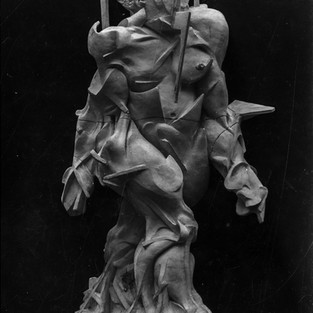Umberto Boccioni: Recreating the Lost Sculptures - Estorick
- Kathleen Bondar

- Sep 27, 2019
- 3 min read
Updated: Aug 20, 2021
Entering the Estorick galleries the sight of Boccioni’s lost sculptures recreated by digital artists Matt Smith and Anders Rådén using a combination of vintage photographic material and cutting-edge 3D printing techniques, is impressive. Boccioni’s best-known three-dimensional work, Unique Forms of Continuity in Space is represented on the Italian 20c coin. In Recreating the Lost Sculptures, Smith and Rådén have resurrected three earlier sculptures and a volumetric study of a head which were lost to the avant-garde in 1927. The actual sized models stand before larger sized photos of the originals. The painstaking and finite techniques employed in resurrecting these sculptures are explained in text, imagery and witnessing the actual recreations.
Images top left to right: Matt Smith and Anders Rådén Digital rendering (contour) of Empty and Full Abstracts of a Head; Umberto Boccioni Empty and Full Abstracts of a Head 1913 Contemporary photograph of destroyed plaster original; Umberto Boccioni Study for ‘Empty and Full Abstracts of a Head’, 1912. Bottom left to right: Umberto Boccioni Speeding Muscles,1913 Contemporary photograph of destroyed plaster original; Umberto Boccioni Spiral Expansion of Muscles in Movement 1913 Contemporary photograph of destroyed plaster original; Umberto Boccioni Synthesis of Human Dynamism, 1913 Contemporary photograph of destroyed plaster original.
What is unique about the Futurist artists is how they adapted the Cubist technique of using fragmented and intersecting surfaces and outlines to show several simultaneous views of an object in still life into depicting speed and movement. Boccioni’s statues can be understood in this context. A human figure is not portrayed as one solid form but composed of the multiple planes in space through which the figure moves. And there is certainly a sense of power and movement in the recreations: Synthesis of Human Dynamism, Speeding Muscles and Spiral Expansion of Muscles in Movement. These radical departures from classical sculpture were so ahead of their time, even today, over a century later, their influence can perhaps be seen in sci-fi models such as Transformers.
However, there is more behind the Futurist movement which cannot be ignored, namely its links to fascism and anti-feminism. The Futurist movement, led by Filippo Tommaso Marinetti, began in the early twentieth century with a group of young Italian men - Umberto Boccioni, Carlo Carrà, Luigi Russolo, Gino Severini, and Giacomo Balla - passionate about change to the status quo through dynamism, speed, energy, the power of the machine and industrialisation. This translated to a reaction against museums and libraries as static institutions belonging to the crusty old past. The Futurists endorsed violence and the advent of war (ironically, Boccioni was trampled to death by a horse during training). After WW1, the Futurist's intense nationalism led to an alliance with Benito Mussolini and his National Fascist Party.
It also led to a bewildering reaction against feminism which might be explained in the context of associating masculinity with industry. Some say it’s to do with moving beyond the Italian tradition of celebrating the female form, although that tradition also embraced the male form (see Capital Reviewer reviews on Michelangelo and The Renaissance Nude) and so doesn’t quite stand. From his sculptures, Boccioni certainly revered the muscular, powerful male form.
Boccioni died before the Fascist alliance, however. Somehow his plaster statues were left under the care of another sculptor named Piero da Verona who subsequently disposed of them for some unknown reason. Perhaps the plaster had disintegrated or perhaps the sculptures had been destroyed during turbulent political times. Whatever the cause, the recreations by Smith and Rådén are an art in themselves and a homage to the originals.
25 September – 22 December 2019
Estorick Collection of Modern Italian Art,
39a Canonbury Square, London N1 2AN
T: +44 (0)20 7704 9522
Twitter / @Estorick
Facebook.com / estorickcollection Instagram.com / estorickcollection
Opening Hours
Wednesdays-Saturdays 11.00-18.00, Sundays 12.00-17.00
Closed Mondays & Tuesdays
Admission: £7.50, Concs £5.50
Transport: Tube/Rail: Highbury & Islington (Victoria Line / London Overground / Great Northern); Essex Road (Great Northern)
Anders Rådén is a digital artist and designer. He lives in Uppsala, Sweden. https://www.ardi.se/
Matt Smith is a digital artist and designer. He lives in Liverpool, England.














